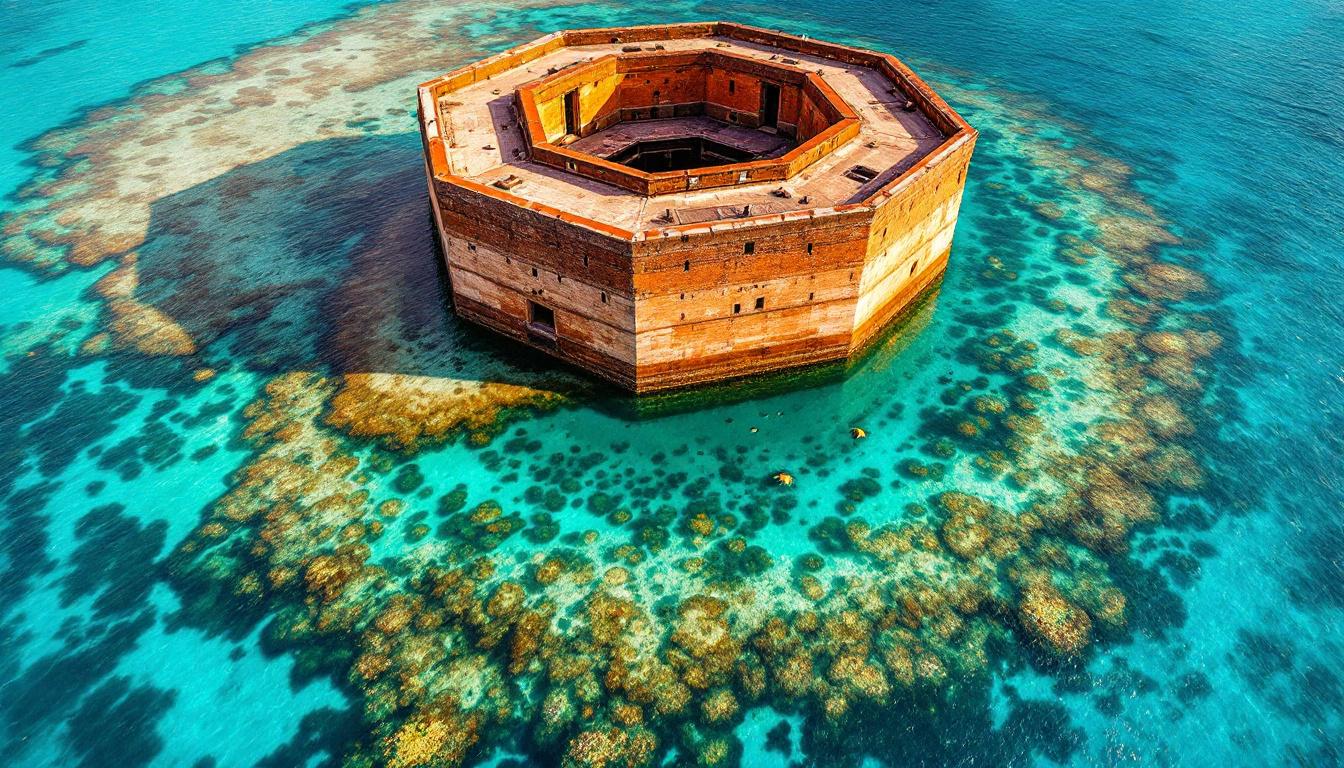Seventy miles beyond Key West, where the Gulf of Mexico swallows civilization whole, sits America’s most exclusive national park secret. Dry Tortugas National Park stands as the only place on Earth where Civil War prisoners once shared coral paradise with five species of endangered sea turtles.
This isn’t just another tropical escape—it’s the singular American wilderness where Fort Jefferson’s massive brick walls rise from pristine waters that have sheltered marine life for centuries. No roads reach this sanctuary. No crowds disturb its peace.
What makes this 64,700-acre park truly remarkable isn’t its size, but its impossible combination of experiences found nowhere else in the United States.
The fortress that became America’s most remote prison
Civil War secrets locked in coral waters
Fort Jefferson stands as the Western Hemisphere’s largest masonry structure, built from 16 million bricks transported by ship. During the Civil War, this offshore fortress served as the Union’s most secure prison, confining deserters and four conspirators in Lincoln’s assassination including Dr. Samuel Mudd.
Architecture that defies the elements
The fort’s six-sided walls rise 50 feet from Garden Key, engineered to withstand hurricanes and siege warfare. Walking these ramparts today, you’re exploring the only 19th-century coastal fortress still surrounded by its original pristine marine environment, untouched by modern development.
Marine sanctuary where five turtle species thrive
Endangered giants in crystal waters
Dry Tortugas protects the only nesting site in America where all five sea turtle species converge: loggerhead, green, hawksbill, leatherback, and Kemp’s Ridley. During summer months, these ancient mariners emerge onto moonlit beaches in numbers found nowhere else in Florida.
Coral reefs that escaped destruction
The park’s remote location preserved coral formations that died elsewhere from pollution and boat traffic. Snorkeling here means swimming through living coral gardens that represent what Caribbean reefs looked like centuries ago—a marine time capsule accessible only to those willing to journey 70 miles from land.
Access that keeps the masses away
Seaplane adventures to nowhere
Reaching Dry Tortugas requires commitment: $400 seaplane flights or 2.5-hour ferry journeys aboard the Yankee Freedom II. This natural barrier filters visitors to just 63,000 annually—fewer people than visit popular Florida beaches in a busy weekend.
Camping beneath unmarked stars
Only eight primitive campsites exist on Garden Key, available first-come, first-served. Spending the night means experiencing zero light pollution and dawn turtle watching that transforms casual visitors into conservation advocates. Pack everything—no supplies exist beyond Key West.
The conservation story that continues today
Scientific guardians protecting paradise
Rangers monitor turtle nests daily from May through October, continuing research that began in 1980. This scientific presence ensures that every visitor witnesses active conservation while learning about marine ecosystems that exist nowhere else in America.
Cultural heritage meets environmental protection
Juan Ponce de León named these islands “Las Tortugas” in 1513 for the turtles he found grazing seagrass beds. Today’s Leave No Trace policies honor both the Spanish explorer’s discovery and the delicate balance between human wonder and wildlife protection.
Planning your journey to America’s secret paradise
When turtles and weather align perfectly
July through September offers peak turtle nesting activity, though hurricane season brings weather risks. Book Key West accommodations months ahead, as this gateway city fills quickly during turtle season.
What makes the investment worthwhile
Ferry tickets cost around $190, seaplane flights $400+, but experiencing America’s only fort-reef combination creates memories worth every dollar. Compare this to Caribbean resort packages exceeding $2000 for similar coral access and historical significance.
Essential preparation for paradise
Bring reef-safe sunscreen, snorkeling gear, and camping supplies if staying overnight. The park’s pristine condition depends on visitors following strict environmental protocols that protect both coral reefs and nesting turtles.
Dry Tortugas National Park represents the only place in America where Civil War history, endangered wildlife, and pristine coral reefs converge in perfect isolation. This isn’t just travel—it’s pilgrimage to our nation’s most exclusive natural sanctuary.
Every visitor becomes a temporary guardian of this underwater cathedral and historical monument. Book your seaplane or ferry passage to witness why America’s hidden national parks reward those bold enough to venture beyond the ordinary.
